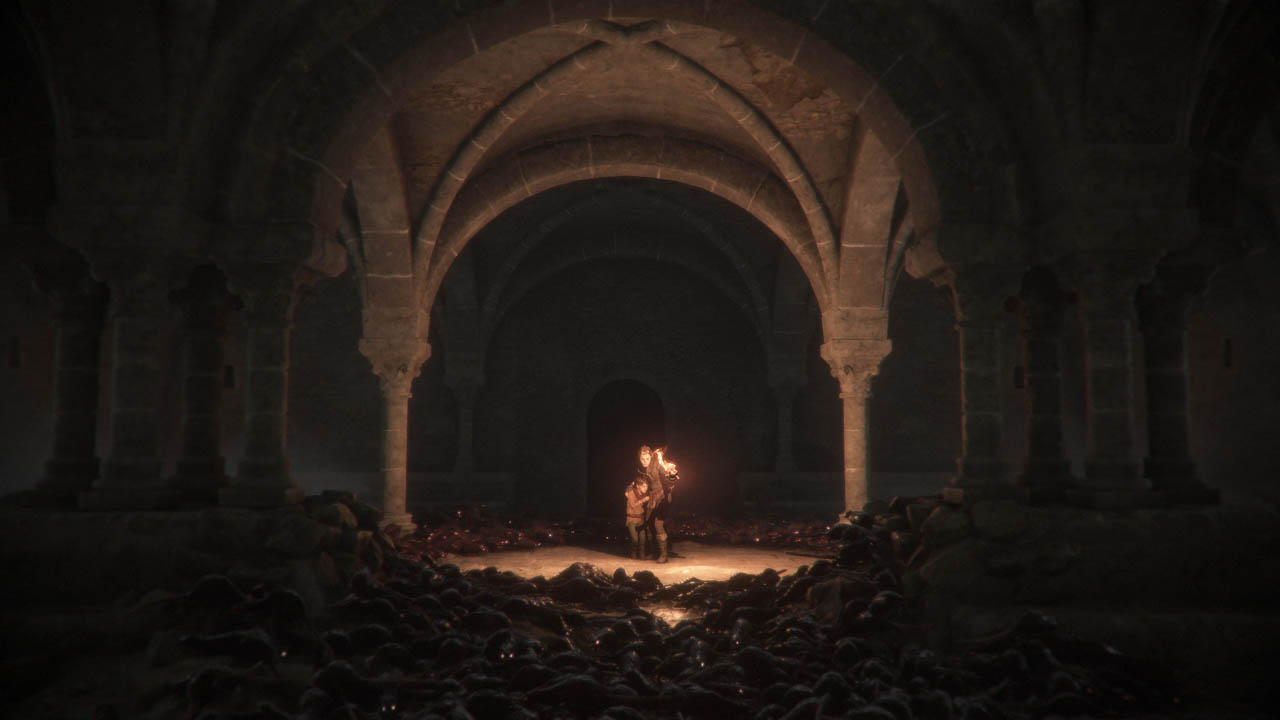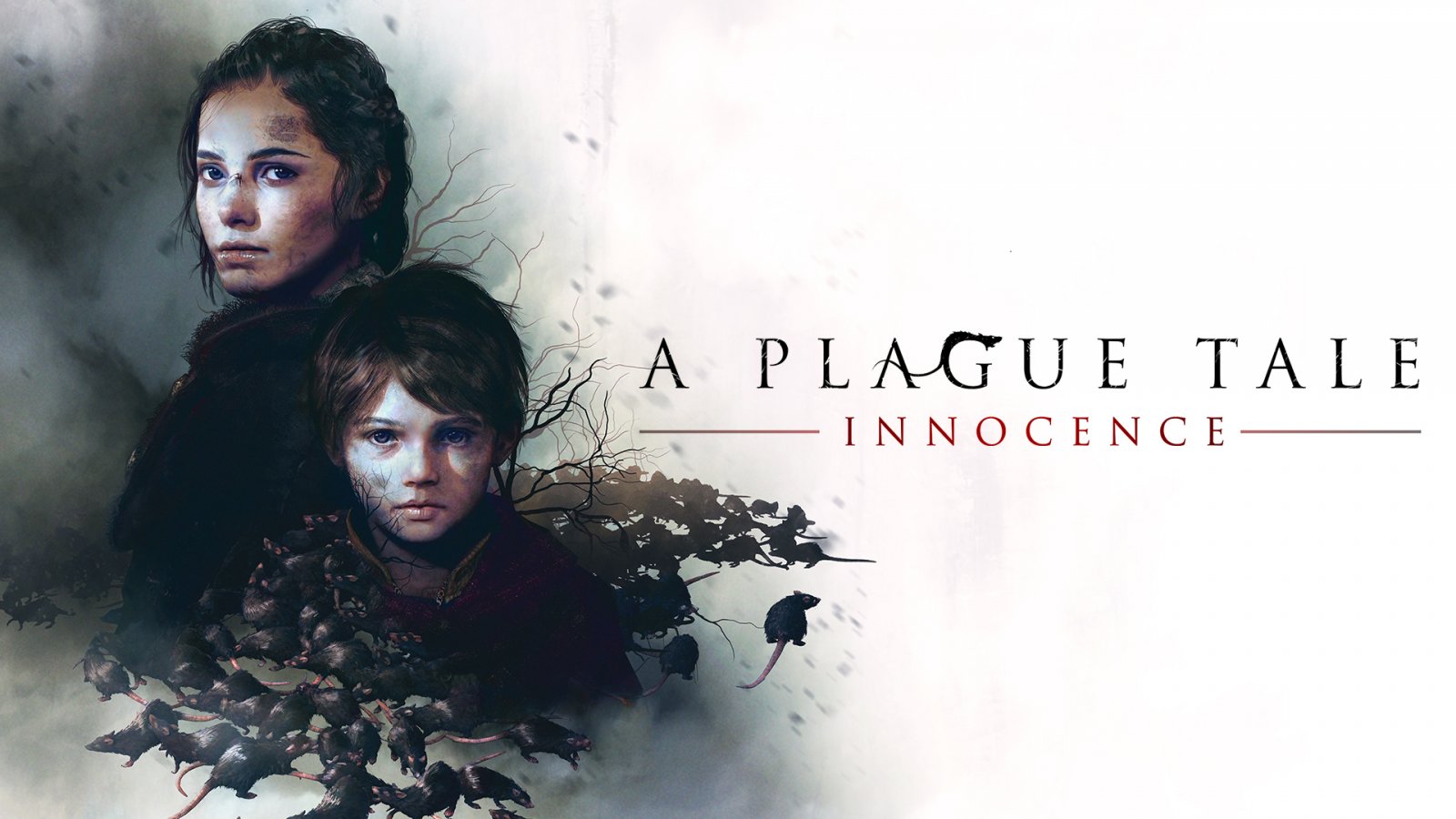Edited by: Tiffany Lillie
For us fans of stealth rat-‘em-up puzzle games, truly satisfying entries into the genre are few and far between. What’s that you say? Rat-based stealth puzzlers aren’t a genre? Then how do you explain the smashing success of Rodent’s Revenge for Windows 3.1, you pleb? And for fans of that classic title, there’s now something that nearly reaches the former glory of the rat stealth puzzle genre: A Plague Tale: Innocence.
But how many rats are there really?
There are seriously so many rats. Imagine as many rats as you can and then double that. It’s clear even from the menu screen that there will be a lot of rats ahead, but I can’t emphasize enough just how many there are.
But that’s kind of a double-edged sword for Plague Tale, because my first impression was unfortunately, “Why do the rats look like rubber toys?” On its surface, this seems to be a game for people that get a kick out of practical jokes where they throw a fake rat on their sister. But the reason for the fake-looking rats becomes clear when you actually experience the sheer volume of them: If there was any more detail on all those rats, your computer would crash and burn. That’s how many rats there are.
In other words, they went for quantity over quality. But it’s actually easy to see why once you’re introduced to the plot and puzzles.
There’s more to it than just rats… right?

This really is a story about rats, but there are strong reasons for that, and once you see it unfolding, you start to realize Plague Tale is something special. The game is set in 14th Century France during the Black Death, The Inquisition, and the Hundred Years' War. The story centers around a group of orphans that find each other and try to survive in a world where there are plenty of reasons for children to become orphans.
And while The Inquisition and the Hundred Years' War can be and are depicted in horrific ways, the Plague is something less tangible. The way Plague Tale handled this is by materializing the plague in the form of rats. Lots of rats. Rivers of rats. And this turned out to be a great choice because video games are the perfect media for bringing to life the very real horrors of history through the fantastical lens of a group of imaginative children. The metaphor fits perfectly.
As a result, the puzzles are deeply entwined with the plot. Rats are afraid of fire, so you need to clear paths of light through their black, teeming masses. One misstep and the rats swarm you, devouring you. Needless to say, such a visceral representation is more effective than using realism to show just how terrifying the Plague was.
In many ways, Plague Tale masterfully balances fantasy and realism.
At first, the attention to detail on the character models seems like a bad choice, because there’s just something off about models that are trying to mimic life, even with the graphics cranked as high as they will go. My first fear with Plague Tale was that it didn’t learn the lesson of Kingdom Come: Deliverance, which is that hyper-realism doesn’t often work — simply because real life is boring.
Instead, Plague Tale lets you know that you are definitely in 14th Century France with the clothing, the architecture, and the traditional instruments used to compose the score, but you’re not reading a textbook. Instead, you’re a teenage girl with no idea what’s going on except that the Inquisition is after your sick brother, the townspeople don’t trust anyone, and there are battlefields filled with the corpses all around you.
Against this backdrop, the inclusion of things like an evil Grand Inquisitor experimenting with alchemy, terrifying nightmare sequences, and a few mystical powers becomes a powerful contrast to the bleak realism of the setting. One of the most horrifying and moving scenes in this historical game isn’t even real, and you as the player know it the whole time because you saw the character get knocked out.
The most genuine parts of the game are the relationships.

Continuing along the theme that the most historically accurate retelling is not always the most effective, the characters were the most important part of this tale. While the little brother’s squeaky voice is a little annoying, he’s still ultra cute and it’s because his cute moments aren’t forced. A great example of the opposite is Life is Strange 2, where the sibling relationship is pushed on the player by making up a weak reason for them to travel together (it’s magic!) and reminding us they’re brothers at every opportunity. (Even with the autosave icon, which is a giant animation of two brother wolves running.)
Plague Tale takes the opposite approach, even giving you the option to go without a user interface altogether. Everything is therefore about immersion and emotion, and most importantly, every element relates to the story. It’s therefore legitimately endearing when the little brother gives his sister Amicia a flower to put in her hair. Each time it’s a different flower, and he knows the medicinal properties since he’s been sick all his life and was cared for by their absent mother. The flower in Amicia’s hair stands out against this dark background and brings you some brightness until you get distracted by the next obstacle and the flower falls out somewhere along the way.
Another reason this is so effective is because Amicia is legitimately adorable. The teenage girl is the perfect protagonist for this story, and she’s very refreshing since there are basically zero games with female protagonists that aren’t sexualized objects. Amicia is just trying to get her brother and herself to a safe place so she can find out what’s going on. Her father, a knight, taught her how to use a sling, and that’s all she has. In other words, when you’re first put in her shoes, you feel pretty helpless. That, too, is a refreshing feeling for a video game.
The gameplay serves the story too.
And that’s where the mechanics come in. As a small girl, you don’t have much going for you in a head-on fight. Stealth, distractions, and agility are your friends in Plague Tale. That, and your actual friends. Because other than sneaking behind guards, puzzling out ways to get past obstacles, and firing off quick shots with your sling, you’re working with other orphans to make it through this harsh life.
To be honest, when I saw the trailer I almost wrote this title off because I thought, “Great, a game-length escort mission.” And when the first orphan joined my crew I thought, “What’s better than an escort mission? DOUBLE escort mission!” But thankfully the AI doesn’t get you killed very often, and each new character introduces new mechanics. Now, instead of the other children feeling like liabilities, they feel like part of your team, and that serves the message of the plot perfectly.
So, it is with great disappointment that I tell you…
What I’ve been saying this whole time is that Plague Tale did what a game should do — what any media should do — and that’s use the medium to best tell the story. That much is evident because Plague Tale would not be as effective if it were a film or a novel. You just can’t feel the metaphor of things like rat puzzles in those formats.
In other words, this is a beautifully-crafted experience, and I haven’t even mentioned the excellent score, the amazing artwork featuring (among many other things) an infested cathedral in stunning detail, and the great voice acting. Well, that is except the one character that decided to go with an English accent instead of French because it’s a fantasy game and fantasy equals English accents. But other than that, everything was beautifully put together.

All except one thing: The game is on rails. Every map is extremely linear, and you’re railroaded along to each new scene. There are multiple ways to solve the puzzles, especially as you gain alchemy crafting recipes (which are thankfully kept to a streamlined minimum), but you can never shake the feeling that there’s one intended path the developers wanted you to follow. The other solutions just seem incidental, as a byproduct of the game mechanics rather than an intentionally-designed approach.
While this allows for choreographed scenes with excellent dialogue, the admittedly impressive level design is still lacking in that one thing that makes a game a game: player choice. And we’ve known since Thief III that making a stealth game linear can kill an entire franchise.
As a result, Plague Tale is a gripping story with excellent characters, but the gameplay is unfortunately a little bland. Still, there’s something special here. A Plague Tale: Innocence is possibly the best attempt so far at becoming interactive cinema. Ironically, it does so by leaning into the strengths of the game medium and abandoning the idea that games need to be like movies or books. Just a step further, and this may have been a masterpiece.
The Verdict: Excellent
A Plague Tale: Innocence is a masterfully-narrated story where each and every set piece is in place. The plot, writing, voice acting, score, and artwork all combine for a moving experience that could not be told in any other media. Unfortunately, all this perfectionism comes at the price of railroaded gameplay. What could have been a revolution is instead just a great game.


